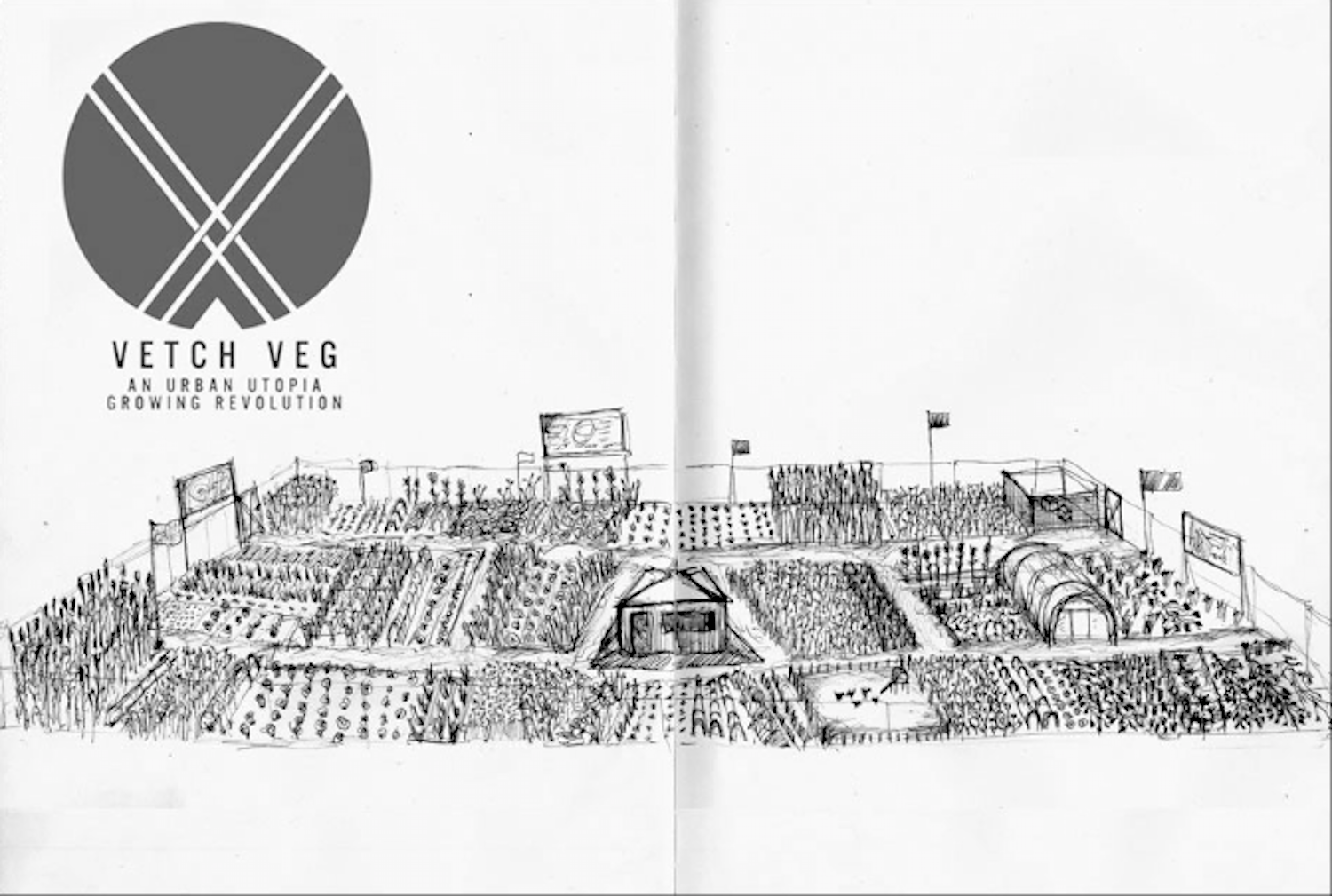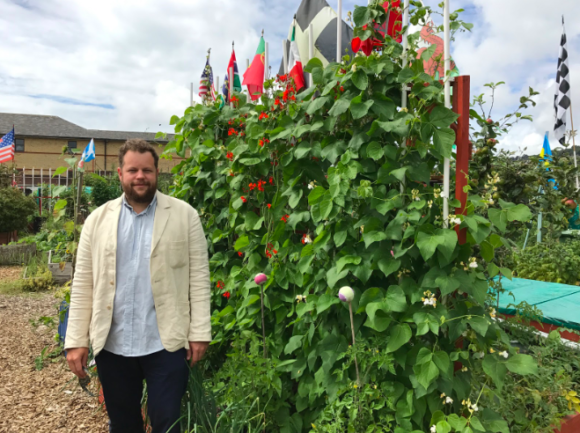
Essentially, it’s about: how can you subvert an artistic process to also be a useful one?…I think what’s happening in my practice is that I’m realizing that there’s an archipelago of projects which don’t necessarily function as art projects now, but were afforded or created through the mechanism of an art project and now continue in another way. I like the idea of the legacies of these projects being connected up. I think the strategy is part of a broader process of the need and the want to collaborate. Whether it’s with a housing association or with a local government, a gallery, or with other artists.
Owen Griffiths is a social practice artist based in Wales, UK. Focused on site-specific, community-based projects, his work utilizes multiple mediums, including community gardens and edible landscapes, architecture, green public spaces, and more. Griffiths uses “art projects” as tactics to enter into publicly-owned spaces, transforming them into beautiful and useful landscapes that are co-authored by others in the community. Ultimately, this tactic beautifies the space, creates community buy-in, and keeps the space in the hands of the people – rather than sold to a private corporation.
This interview was conducted in conjunction with the British Council’s Arts and Social Practice fellowship, of which Griffiths was a fellow in 2014.
Sarah J Halford: Can you tell me a little bit about your practice and how you came to it?
Owen Griffiths: I’m an artist. I work in the social practice realm of things. I work with communities, and on the basis of co-authorship and collaboration, which is sort of central to the practice. That means that sometimes with a gallery, sometimes with a community, or an institution, or organization. And it’s based around trying to work in conversation with as many partners as possible to create the work, or create a change, or create whatever the project is. So, my work is about seeking out the kind of constituencies that kind of feed into the process, place, or the objective of the work.
I had a kind of fairly traditional route to becoming an artist. I went to art school and got a B.A. and then an M.A. But where I work in South Wales, working with social practice here isn’t necessarily something that’s happening all the time. We aren’t as fluent, necessarily, in some of these ideas here in places like the UK – in Britain and in Wales. But I think there’s a real urgency around the political climate, the economic, social, environmental climate, and what’s happening in Europe where this work can actually play an important role in countries like Wales. So, even though I call it an artistic practice, and it’s sort of talked about as an artistic practice, it’s sometimes hard for galleries to get into that or think of a way of working with me. So, I tend to author a lot of projects myself or with other artists. Or work with communities on things.
SJH: For those galleries or to someone who maybe doesn’t know much about ‘social practice art’ – how would you describe yourself as an artist?
OG: I would say that I’m a social practice artist – I think that term is really important. But I think also what I’d say is that I’m really interested in finding out the potential of a place or a community through looking at the vernacular of a place, or things that are specific to that situation. I’m really interested in looking at the quality of that stuff, how we can build cultural confidence and build cultural partnerships. Whether it’s about celebrating their locale, or their role in that locale, or re-politicizing people to play a role in their community. So, that’s what I’d say – I’m interested in that work. That can take lots of different forms. But it’s not about saying that there’s a form to each project, and it’s not like you get the same project every time. You change and adapt, you’re site-responsive, you’re dialogue-responsive. So, you have to kind of move and shape-shift a lot with this kind of work.

Pictured: Vetch Veg – Swansea, Wales
SJH: Can you give me an example of a project that you’ve done that you thought went really well?
OG: I think the Vetch Veg project in Swansea was a seminal moment for me in how this kind of work develops and how I found my language as an artist. I was asked to look at the idea of developing a project in my local environment, and there was a football stadium that was being demolished just in front of our house, before you get to the sea in Swansea. It was the centenary of the football field, and they took the thing down and moved it out of town. So I thought, how can we develop this piece of land and how can we talk about what it’s future will be when it’s had this kind of iconic symbolism in the city for a hundred years? So, we ended up making a vegetable garden in one section of it. That is still there, 5 years on, and about 150 people garden and grow stuff through this project.
I think before I’d been working in and out of galleries, or on the fringes of things. I’d been teaching a bit, I’d been working with communities or children and educational stuff. And this project really accelerated the understanding of what social practice could be. And, also, I lived within a square mile of this place. So, it was a project that happened through the Cultural Olympiad in the UK in 2012; I basically worked on this thing every day for 2 ½ years, so it really took over my life. But it was incredible because what you’d see when you go there is that this is a functioning and sustainable resource that was created through the the processes of art but is now no longer talked about, or needs to be talked about, as an art project. It just exists as a community resource, which is really exciting.
But, what’s really interesting is that this vegetable plot influenced the future of the site and influenced people’s political and social consciousnesses in the area. To connect to this piece of land and say, “actually we want to keep this piece of land – we don’t want you to sell to Tesco. We think this is a really important place to keep green.” Because often in city centers we have a lack of green spaces or resources for children, a lack of tranquil spaces, and the connection between places like that and mental health are really, really huge. So, how, as an artist, can you work with a community on a project like that to help to be part of a conversation about what the future of this piece of land is, and how can you be an author of this piece of land rather than give all of that to the council?
Because we presented this idea to the local authority that owned the piece of land as an art project, we weren’t seen particularly as serious threats in the sense of – we’re taking ownership of a piece of land. Because we called it an art project, they let us do it because they thought it would either fail or it would be temporary or it would just be something for the Olympics and it would move on. But, as I said, 5 years later people are still there and the park is now green. Now, that’s not all because of the Vetch project, but it did play a significant role in how that piece of city center green space has been altered and kept green. So, I’m very proud of that piece of work and of the collaboration that we worked with in the area.
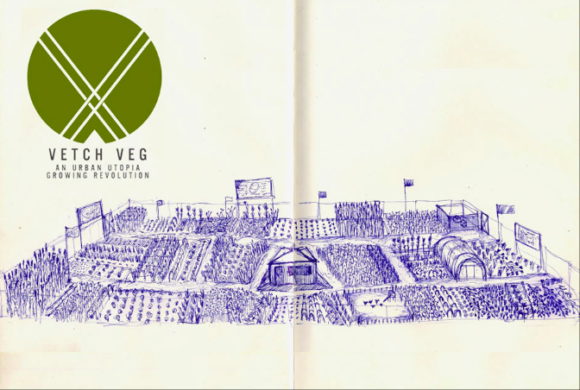
Pictured: A sketch of Vetch Veg – Swansea, Wales
We were there every day, in the rain, building raised beds for planting. The stadium was compacted into building waste that was buried underground. We scavenged bits of football stadium roof for the cafe and the shed, and all of the other things that we used, the roof of the bread oven, all of those things. We just borrowed materials from the demolition. So, it’s how a project like that can be a kind of social connector in that area – how this endeavor of creating a garden can bring a lot of people together and cross lots of boundaries.
The best thing was when we had 10 tons of topsoil delivered, because the kids would just climb this mountain of topsoil and play on it. Just to be outdoors with their neighbors and their families, that’s really great in an urban area to have experiences like that. Now, kids go there after school, they water the plants, there’s an old pipe where they’ll play with the water, and people are growing stuff – maybe not to feed their whole family on that stuff, but actually it’s a social space. That’s really important, as well as the growing. It’s sort of talked about, in Wales anyway, as a project which has started a conversation about what it is to work in your local area, what it is to work in communities, what social practice can be, and is recognized as an example of good practice, which I’m really thrilled about. But I definitely learned so much by doing it because I’d never done such an ambitious thing before, and it really changed the way I work and practice.
SJH: As a community garden, you obviously needed the community. So, how did you get their buy-in to work on this project?
OG: We basically just went around, knocking doors and talking to people and went for pints in pubs and talked to people about the project. We put posters up, and got people to just come and see it. We worked with local counselors, we worked with sustainable groups in Swansea to talk about the project, we just went around and chatted to people.
And, also, we realized that regular consultation groups weren’t the way to go – questionnaires and things. It needed the human conversation, which you can’t just do in a form and send in the form. It was really important to go meet people and talk to them. What would happen then is that people would say, “I’ve never talked to my neighbors and I’ve lived on this street for 20 years.” And you just thought, well that can’t be, surely, but actually these things are really common.
It was really interesting to see things like racial tensions come to the surface, and the changing relationship to the community – the effect of the student population, the Chinese community, the Bangladeshi community that lived in this area, and people who were from Swansea and born and brought up there. So, it was all of these stories coming together, and whatever these urban conflicts are – conflicts around parking, or whatever, that you find in areas of dense housing, it was really interesting to say, “well, we’re not going to talk about any of those things – what we’re going to do is build this thing together. And, none of us are gardeners, so let’s just try to build this infrastructure together and develop this project.”
And then, throughout that year it was building that community partnership, really working with lots of different groups in the community, encouraging the Chinese retirement home to be part of the project, encouraging the churches and the tenants association, and all of these different groups that are active to come and be part of the project. I worked with about 4 or 5 people who were totally key and who emerged as community leaders to the project who really saw the project through and are very active there today.
SJH: It sounds like the community was really hungry for something like this.
OG: Yeah, I think we just hit the right time. Nobody had asked them what was going to happen in this piece of land. They’d lived with an empty stadium for 5 years, which had gone into dereliction, and no one had ever really had conversations with them about what this could be. So, having established this community confidence through the work that we were doing, we felt capable of challenging some of these prescribed ideas or possible routes that this piece of land would go down.
SJH: Why a garden? Why not a community center or just make it a dog park or something?
OG: Well, they have a community center, they have a beach across the road where all the dogs go. It was more about creating a green space, really, than a vegetable garden. It’s not as prolific of a growing space that you could have if you didn’t have individual beds. But it felt necessary to have individual plots so that people might have a plot next to someone they didn’t know. You wouldn’t necessarily be next to your neighbor, but you might be next to someone you’ve never met before. Mixing it all up like that was quite key when we came to work on this.
SJH: How does a garden like this fit into your larger “social practice”?
OG: I think that since Vetch Veg the gardens have been quite a theme in my work, because what it gives you is a space to nurture something, a space to talk about everything – politics, place, community, identity – you can talk about all that stuff, but you can do it while moving soil or building something. So, really, it’s kind of a vehicle to get to the conversations and get to the work that you want to do. I suppose that I’m probably a frustrated landscape designer because I love the idea of these spaces as anti-capitalist spaces that are somehow connected to a community-oriented belief. So, in a privatized landscape, I think about how spaces like these have a real strategic importance, as well as a biodiversity importance, as well as a social, political, cultural importance. So, they kind of work on lots of different levels for me. And being outdoors working with other people is just such a great experience for people to connect food politics to a sense of place. I don’t always make gardens, but they’re definitely a theme that I’ve been working with.
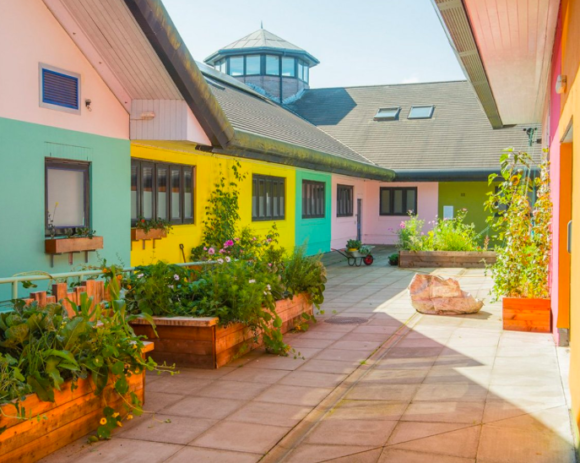
Pictured: Hillside Secure Children’s Home – Neath, Wales
I also worked, as well, in a secure unit for 12 to 16 year old kids, which was basically a prison and a school all rolled into one, and they lived on site, just outside Swansea. We made a garden there as well because often in institutions like that, the outdoor spaces are not very cared for, there aren’t enough resources to look after them, and people aren’t empowered to take them on.
The prison project was in a place called Hillside Secure Unit. Its courtyard is basically the only space that the kids all use at some point in the day, crossing it to go to class or whatever. And it was a completely unloved space that was just mossy and damp and just really boring. So, we talked about linking that space to a pedagogical role. We created a raised bed system again and we worked with the kids and staff to develop an outdoor classroom, essentially, and a space where other conversations can happen.
Especially when you’re in a high security institution, sitting in a polytunnel and hearing the rain fall on the polytunnel and having a conversation with your therapist is such a nicer experience that sitting in a strip-light room where the furniture is bolted down and everything around you is about hostility and coldness. Even though the staff might be trying to bridge those gaps, the architecture is working against you all the time.
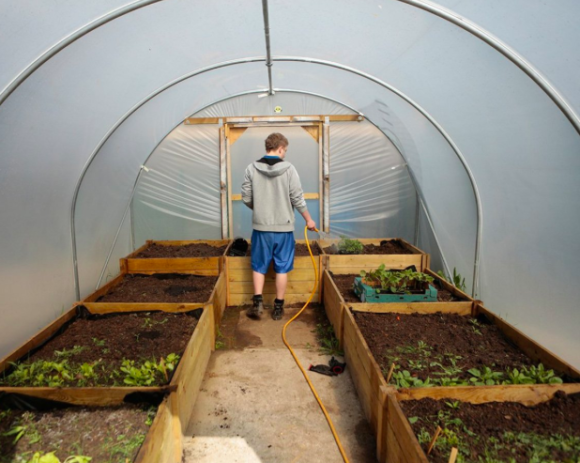
Pictured: Inside a polytunnel at Hillside Secure Children’s Home – Neath, Wales
So, after consultation with the staff about what we were trying to do and how it would work, this outdoor class would be a place where we could have conversations, they could have family visits there, and the beds were just chalk-full of stuff. It was a really rich biodiversity – a complete mixture of planting. We grew everything with the kids, so you really get to talk about the idea of the seed growing into the fruit. We would connect that garden to a bigger conversation of things in the outside world and how in a few years time when they might be leaving that place or going onto a different institution, how they’ll work with that. So, those transitional conversations about place, and also abstract conversations about life and the world and our place in it, ecosystems and materials, all these things. It’s just a great vehicle to talk about all of this stuff.
SJH: Did you have any specific goal in mind when you went in and did that end up changing by the end of it?
OG: The goals of the prison projects are really open because the environments are so different. They have different categories of people who are in there for different reasons, with a massive difference in needs and mental health, so you’ve got to be really flexible to sustain a conversation with a place like that. That is the goal: if you can have a conversation with the institution and create something that hopefully lasts beyond your intervention as an artist. So, the fact that the garden in Swansea and the Hillside gardens are still there and still used is a great result in that sense. We can leave something that doesn’t need prolonged artistic intervention to keep it up. So, I think that’s the goal when you go into a situation like that – how can you create something sustainable and useful through the project? How can you manipulate an artistic process or artistic funding to create a wider conversation about what the usefulness of this is?
SJH: What is it about these conversations that’s so important to you?
OG: Well I think that the conversations that you have as an artist – they’re interesting because you’re kind of like a trespasser, you’re coming maybe with no expertise in this sector, and you’re allowed in through the label of an artist to work with people or an idea, so there’s a sense of privilege around that a lot of the time. What’s amazing is that people will tell you stuff. You have amazing conversations with people about all kinds of things. But it’s incredible to learn about the perspective of the workplace or the world or politics from people in different situations. It informs your work and what you do, so it’s absolutely key in the way that we create a space and allow people to be heard. How you bring people into the role of a collaborator or a sense of co-authorship. You can’t do that unless you have a real understanding of them.
SJH: Regarding the prison project, you said that there was an effect on the students and educators. What did that effect look like? How did you first realize that it was happening?
OG: I think the effect was almost immediately because they very rarely get the time to spend outside doing something that’s not sports-related. So, to be outside with permission to do things like wheeling a wheelbarrow full of soil, and just really simple tasks like that, you could see how much they enjoyed doing it and how extraordinary the effect was of them being outside and doing something that wasn’t necessarily competitive.
You can use the garden as an example to talk about any educational process. So, that’s what was interesting was that they sort of began to see the possibilities of the garden. And then, we would sit in the polytunnel and have our tea breaks, but instead of having these really bad, sugary snacks we would bring in different, healthier things. And just that somebody had offered them something different and that we were sitting in this polytunnel listening to the rain, chatting, just the informality that the garden gave, you could see this kind of weight shifting – not necessarily lifting, because you’re still in this high-security space – but the sense of having permission to be outside in a different way. And then the staff came to us with ideas – it was their idea to bring the therapists into the garden. We had hoped that things like that would happen, but you never really know, depending on the context and what’s happening in the institution.
So, it was really great because the young people enjoyed being outside in a different way, and then the adults could see the possibilities of the garden as a metaphor for a bigger way of working in spaces like that.
SJH: And what about the conversations that happen within the groups that you work with? You said earlier that sometimes real social or political conversations can come up amongst the co-authors. What do you hope comes next?
OG: I guess you just take things from the conversation…I don’t know the answer to that, really. I think it’s just about…yeah, I don’t look at things like that. I just sort of carry on. They don’t stop, these conversations, they just carry on. You know, like after we’ve left a project, for example, or after I’ve stopped working on something — knowing when to stop working on something, knowing when to stop having those conversations is really difficult, because you might work with a group of people for 2 years and you become friends with them, and you develop relationships with people around this work and these roles and these ideas. There’s a sense of a real, common ownership of a project, and then you leave. It’s really hard for the community, it’s really hard for you as an artist. So, it’s a tricky thing for you to work on. And I think I’m learning how to do it all the time.
SJH: Were those conversations part of how you knew that the project was successful?
OG: Oh yeah, definitely. I think that the difficulty is that the markers of success in projects like this are very subtle, and actually you’d have to ask them what made it a success because my criteria would be different to theirs. Also my criteria is from the perspective of someone who leaves at the end of the day, and their criteria is that they managed to stay out there for an hour without misbehaving or being sent back in or being restrained.
Now, they might not be able to necessarily express the fact that that was a successful experience, but for the staff, they’d say, “Wow, it’s amazing to see so-and-so in the garden, he’s totally different here than he is in an educational context.” And I’d say, “Well, this is also an educational context, it’s just an informal educational context.” We’re talking about a lot of complex things like building, co-planting, but actually the informality and the outdoor element just gave people spaces to breathe. I think that’s so important in a high-tension environment like that. All the kids are between 12 and 16, majority of them in the 16 age bracket. So, they’re like these big teenagers with a lot of energy and hormones kicking around, and so to be outside and to give them spaces to talk about this stuff was really key.
So, yeah, I think the markers of success were kind of always moving and different depending on who was coming in and out, but I think when someone would say something like that to me, it was like – great! Because you might feel like something didn’t go very well, but actually then you’d be informed by one of the teachers that that was a really successful engagement. Specific environments offer different things; you have to attune yourself to those, and that takes a bit of time.
SJH: It sounds like you measure success with a variety of metrics that are based on one’s perspective. Have you felt that way about other projects?
OG: I think it’s with all the projects, really, when you’re working with groups of people. How do you evaluate the experience successfully, and honestly, and how do you use a process of evaluation as a creative process to inform how you go forward? So, you’re not doing it at the end, you’re doing it throughout. And I think that’s the key: to try to work with these processes throughout. And it takes a bit of time, but it actually informs a more sustainable practice of working. You basically get to achieve something that’s a more real connection to a place by adapting things all the time.

Pictured: A community gathering at Vetch Veg – Swansea, Wales
SJH: These sound like incredible projects, but what about the times when things don’t go so well?
OG: Yeah, I’ve certainly had projects like that where things haven’t worked for various reasons.
SJH: Does an example come to mind?
OG: Yeah, sure…I want to be somewhat vague with this because the project is still ongoing. But looking back now I can really see why it didn’t work, but at the time it’s really hard to work out. In a partnership project recently we had difficulty having a conversation with all the key partners. I think that’s a really important part of something. So, when things haven’t worked, it’s been about not having access to the people who have conceptualized this creative project, who have maybe thought: what we need here is an art project, when actually they don’t need an art project. But they bring in an artist and you work on this project and you get to meet people and have conversations, but actually you don’t get to talk to the right people or things aren’t properly communicated.
SJH: So is it that this project wasn’t hitting the right chord with the community?
OG: It’s not necessarily that, I think that when social practice projects don’t necessarily work it’s because what they need is an architect or a better resource. So, I think when it’s not worked very well it’s because they didn’t need an art project or the community didn’t want an art project but the landlord wanted an art project. Or the consultation they’ve done around this is just a form-filling exercise or something.
SJH: So in the project that you’re thinking about, what were some indicators that it was starting to go south?
OG: The fact that they’d say things like, “We’ve done a community consultation and we sent out 300 flyers and nobody showed up.” Things like that where you have a track way of doing things and you’re not willing to change your way of doing things. We were trying to do something different than what they normally deliver, and therefore you might want to change your consult methods. So, things like that were clues to this kind of conversation not going forward.
And, also the fact that we couldn’t speak to the director or the landlord of this piece of land, we were meeting other people. So, sometimes it’s really useful to speak to people at the head of an organization to talk about what this is, because actually what most people are not prepared for is the time that these projects take and the money they take because they can be big beasts sometimes. They take a lot of time and a lot of resources and money and they don’t always necessarily give you a big shiny thing at the end of it.
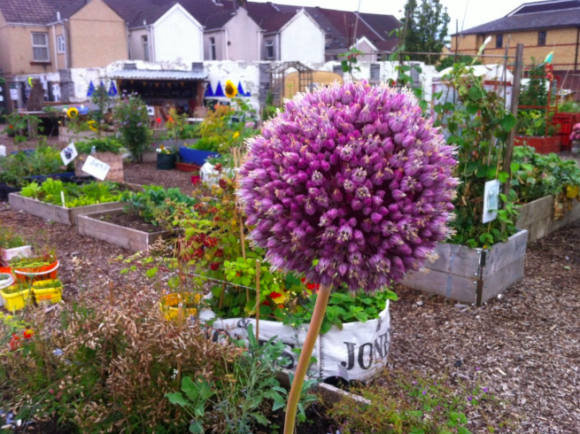
Pictured: Vetch Veg – Swansea, Wales
SJH: Do you connect these community-based projects to a broader idea of social change?
OG: I think so, yeah. I mean, they’re attempting to be – sometimes failing, sometimes succeeding. But I’m working in Wales, and I’m really interested in the idea of small nations as authors of change, and the idea of being based in somewhere like this, working in your locale as well as internationally, as a way of creating a sustainable shift, or a greater participation in something to enable things to happen. Of course, there are loads of other models and ways of doing this not as artworks, which are much more successful or give greater agency or at a greater speed, but I think what’s achieved through social practice can be really unique and really transformative, and can provide a really poetic space for intervention.
But, essentially, it’s about: how can you subvert an artistic process to also be a useful one? So, how can we use a Cultural Olympiad grant or commission to achieve something long term, all the way out in Swansea? I think it’s about that question, really, it’s about the usefulness of this and the utility of it. How can we participate in a greater idea of connection to place, to neighbors, to cities, to urban design, to the questions of the environment around us and how we can participate in those changes and not have things done to us all the time.
SJH: Do you think of your work as one-off projects or do you connect them all together to a larger strategy for change?
OG: I think what’s happening in my practice is that I’m realizing that there’s an archipelago of projects which don’t necessarily function as art projects now, but were afforded or created through the mechanism of an art project and now continue in another way. I like the idea of the legacies of these project being connected up. I think the strategy is part of a broader process of the need and the want to collaborate. Whether it’s with a housing association or with a local government, a gallery, or with other artists.
I think those small-scale changes are inspired by changes on a mass-scale. So they’re a part of bigger changes that I’m not authoring, but they’re part of a much bigger thing. So, the Venn Diagram of how these things connect up to a revolution around how we use land in this country. Or say food justice, social food politics, is the big issue, then this work connects up to that as a small part. So, I feel like there are plenty of enormous social change movements happening that these projects can assist in. I think they’re one and the same, really.
I’m always interested in the idea of collaboration, but I think now it’s about strategic collaborations, probably with other artists, to get these projects moving in a quicker way. That’s what keeps me in Wales and that’s what keeps me working here – the possibilities of working in a small community and creating these changes, creating the landscape that you live in, and also having international conversations from this perspective feels like a really good time to challenge the neoliberal structures, to challenge land privatization, to challenge the lack of green spaces in cities. These are conversations that a lot of artists are having, there’s a lot of artists becoming social practitioners now. It feels like a really rich time.
For more information on Owen Griffiths, visit www.aboutreconnection.com



